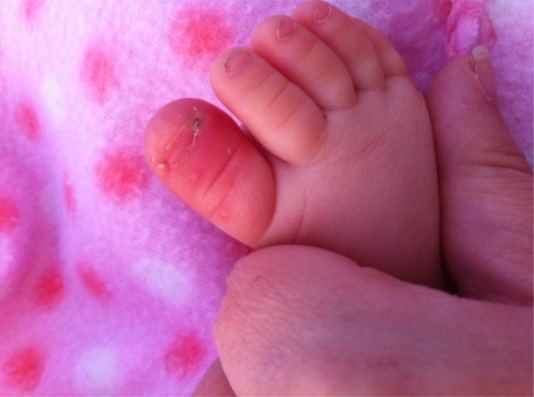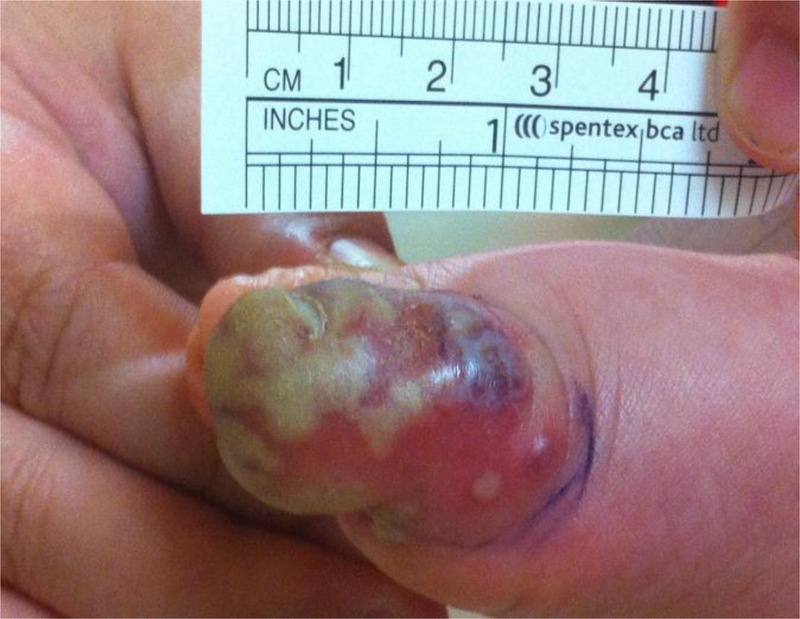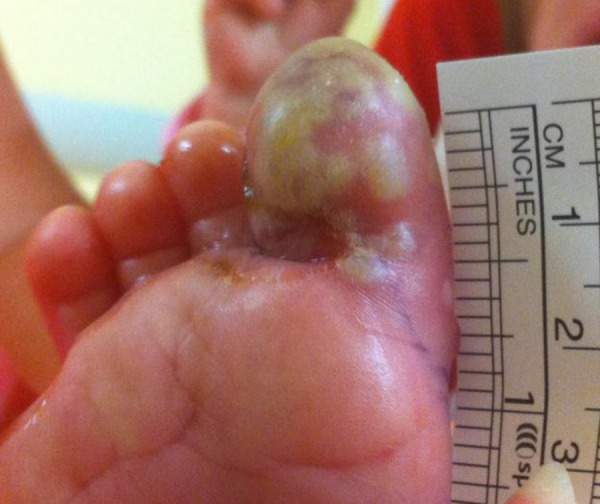Abstract
A 9-month-old baby girl presented multiple times with an erythematous, papular and pustular big toe in an otherwise healthy infant. A diagnosis of cellulitis was made and she was started on oral antibiotics, and bacterial swabs were taken. After 2 weeks of worsening appearance she was admitted for intravenous antibiotics. Inflammatory markers remained normal and viral swabs were taken. No improvement was seen after 2 days and she was referred for orthopaedic and dermatological opinions. The orthopaedic team recommended debridement whereas the dermatologist suspected a primary herpetic whitlow and recommended intravenous acyclovir in addition to intravenous antibiotics. A viral swab for Herpes simplex virus type 1 (HSV1) was positive by PCR on day 3. The toe continued to improve clinically and the patient received 21 days of acyclovir in total. 27 days after discharge the infection relapsed. She was treated with a further 14 days of oral acyclovir and recovered completely.
Background
Primary herpetic whitlow of the toe is extremely rare in paediatric populations.
This case was important to draw attention to the typical appearance and correct management as the appearance can mimic a severe bacterial infection which may appear to require debridement. The management of this case was also facilitated by medical photographs to illustrate the progressive deteriorating appearance of the lesion to different multidisciplinary team members who were not involved in the case from the outset.
Case presentation
A 9-month-old presented multiple times for assessment of an erythematous, papular and pustular big toe in an otherwise healthy infant (figure 1).
Figure 1.

Photo taken by mother's camera prior to admission.
She was discharged twice with different courses of oral antibiotics and multiple bacterial swabs were taken. After 2 weeks of worsening appearance she was admitted for intravenous antibiotics. Inflammatory markers remained normal (C reactive protein (CRP), white cell count) and viral swabs of the pustular portion of the toe were taken.
No improvement was seen after 2 days and she was referred for orthopaedic and dermatological opinions (see figures 2 and 3). The orthopaedic team recommended debridement whereas the dermatologist suspected herpetic whitlow, recommending continued observation and intravenous antibiotics with addition of intravenous acyclovir. Viral swabs were positive by PCR for HSV 1 on day 3. Both her parents denied having HSV type 1 or 2 infection or any contact with HSV 1 infection prior to the appearance of clinical signs of infection in the child.
Figure 2.

Photo taken on day 2 of admission following 48 h of intravenous antibiotics.
Figure 3.

Photo taken on day 2 of admission following 48 h of intravenous antibiotics.
The patient remained well throughout and received 21 days of acyclovir.
The toe continued to improve clinically. The infection appeared to relapse 27 days after discharge. She was treated with a further 14 days of oral acyclovir and recovered completely.
Investigations
Blood markers for infection remained low throughout stay (CRP—6.9).
Bacterial swabs of lesions were sterile.
Viral swabs taken from burst pustular vesicles were positive for HSV type 1 by PCR.
Differential diagnosis
The most common cause of spreading erythema is cellulitis and this patient was treated for this diagnosis. Factors in this case not compatible with a diagnosis of cellulitis were the initial report of vesicles prior to erythema, the patient remaining systemically well (apyrexial) and the lack of improvement with intravenous antibiotics.
Consequently, fungal or viral infections were suspected and this confirmed the clinical suspicion of herpetic whitlow.
Toe sucking was also noted as a differential diagnosis; however, in this case parents had never seen her suck her toes nor had any recollection of others having mouth to toe contact.
Treatment
Initial oral antibiotics were changed to intravenous antibiotics as the toe appeared to worsen.
Three days of intravenous antibiotics were administered with worsening appearance of the toe before a firm diagnosis of herpetic whitlow was made. Clinical suspicion of HSV infection led to pre-emptive addition of acyclovir that was continued for a total of 21 days.
The relapse of infection was treated with a further course of oral acyclovir.
Outcome and follow-up
The patient's toe appeared to return to normal appearance, but within a month the patient re-presented with increased swelling and erythema of the toe. She was given oral acyclovir and discharged.
Discussion
Diagnosis of herpetic skin and soft tissue lesions is often made on clinical grounds; however, herpetic whitlow is often misdiagnosed as bacterial cellulitis. Szinnai et al1 reviewed previous paediatric diagnoses of herpetic whitlow and reported that 65% of cases (n=44) had been initially misdiagnosed. Only 3 of their reported 44 cases suffered infection of the toe and different sources of infection suggested, including ‘toe sucking’. The authors also recorded that as many as 23% were recurrent infections.
No published guidelines are available for management of herpetic whitlow, although it has been suggested that surgical intervention exacerbates symptoms and can introduce bacterial infection.2 3
Learning points.
Consider herpetic infections in isolated, non-spreading erythema involving a digit or toe following vesicle formation in an otherwise systemically healthy patient.
Medical photography is important evidence for illustrating the progression of the lesion to different multidisciplinary team members.
Footnotes
Competing interests: None.
Patient consent: Obtained.
Provenance and peer review: Not commissioned; externally peer reviewed.
References
- 1.Szinnai G, Schaad UB, Heininger U. Multiple herpetic whitlow in a 4-year-old girl: case report and review of the literature. Eur J Pediatr 2001;160:528–33 [DOI] [PubMed] [Google Scholar]
- 2.Bandlow G, Kohlschutter A. Herpes simplex als Ursache eines therapieresistenten Panaritiums. Dtsch med Wschr 1977;102:759–60 [DOI] [PubMed] [Google Scholar]
- 3.Carter SJ. Invited comments. J Hand Surg (Am) 1979;4:93–4 [Google Scholar]


